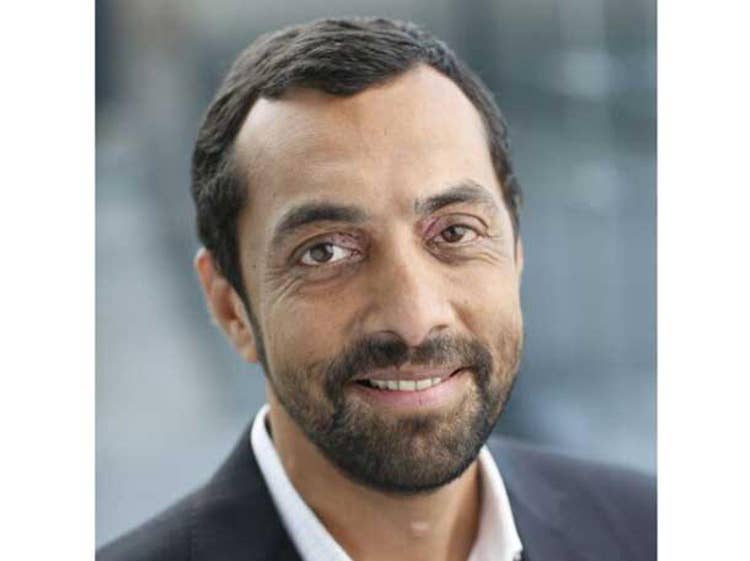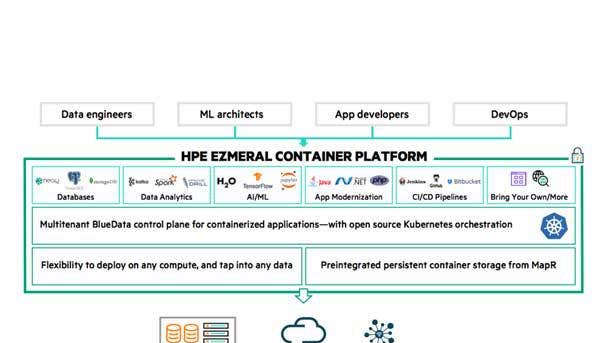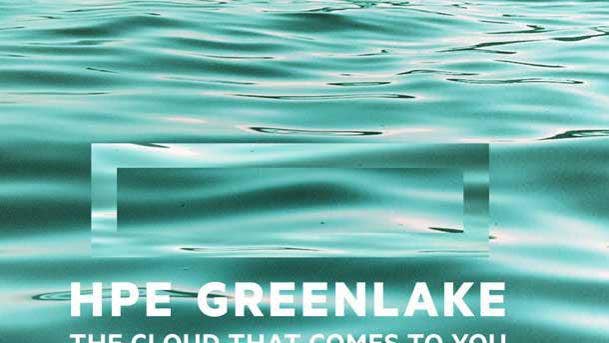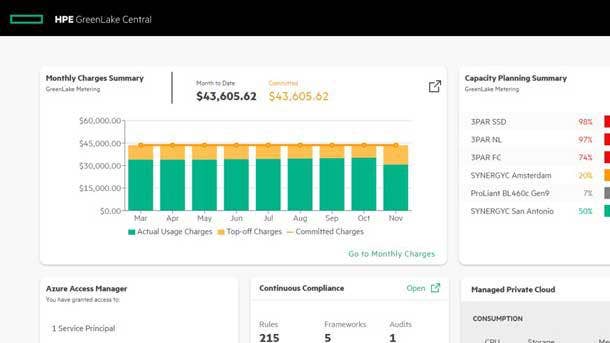GreenLake SVP Vishal Lall On ‘Very Expensive’ Public Cloud Bills, Repatriation And The ‘Value Proposition’ Of HPE’s GreenLake Ezmeral Unified Analytics Service
HPE Senior Vice President Vishal Lall, the head of the GreenLake Cloud Services Solutions Group, says the company’s new hybrid cloud GreenLake Ezmeral Unified Analytics Service will provide “choice” and breakthrough total cost of ownership for customers who have been increasingly frustrated by the high cost of public cloud.

HPE Ezmeral Unified Analytics Platform Takes Aim At High Priced Public Cloud Based Analytics Offerings
Hewlett Packard Enterprise’s is “laser focused” on delivering game-changing total cost of ownership (TCO) that puts an end to expensive public cloud bills for big data analytics solutions with its new GreenLake Unified Analytics on-premises edge-to-cloud platform, said HPE GreenLake Cloud Services Solutions Group Senior Vice President Vishal Lall.
“We are laser focused on making sure the TCO is compelling by doing everything from optimizing the hardware stack to using open source to having a cloud managed model,” said Lall in an interview with CRN. “We are bringing that to either a colo [co-location] or a data center or an edge location.”
That HPE edge-to-cloud prowess is, for the first time, powering a robust hybrid cloud choice for customers who have been frustrated with the high cost and lock-in of public cloud-based analytics solutions and who ran into a “wall” when they were looking for an on-premises cloud consumption-based model, said Lall.
“We are not going in and saying, ‘Give us your data and we’ll lock it up.’ We are saying to customers, ‘We are bringing you an open source, open choice system and if we provide the right performance, the right TCO, of course you’ll give us your business,” said Lall. “But we’ll give you the option of going elsewhere if you want.”
Customers are increasingly balking at the high price of public cloud-based analytics services including from the likes of Amazon Web Services, said Lall.
“Why is two-thirds of Amazon’s valuation based on AWS?” asked Lall. “Because they make a ton of margin. Why do they make a ton of margin? Because they charge a lot [for their services] to customers. At the end of the day, it is that simple. Over time, I think enterprises are realizing this. They use cloud services and know how expensive it is.”
Ultimately, HPE GreenLake Ezmeral Unified Analytics platform is breaking through the perennial public cloud versus on-premises debate, said Lall. “It is not about on-prem, it is not about public cloud, it is a matter of making sure you put your workloads exactly where the economics and performance make sense,” he said.

What’s the value proposition of the new HPE GreenLake Ezmeral Unified Analytics Platform for hybrid cloud environments?
This is all about the value proposition to the customer and there are multiple levels. There is performance, TCO [total cost of ownership] which is a big deal. The third one is choice and the fourth one is around [the cloud] experience. Right now, people are feeling locked in. Those are the differentiators. That is the value proposition. If you take this all the way back to the customer those are the needs. What we are doing is designing to those needs.
What are the market dynamics of the unified analytics and data warehouse market as you bring HPE GreenLake Ezmeral Unified Analytics Platform and HPE Ezmeral Object Store to market?
If you think about back in the 80s and 90s we spent all our time talking about data warehousing and structured data with Teradata or the Oracle database, etc. That worked pretty well until around the Autonomy time frame when unstructured data became a very big deal and it was all about unstructured data and HDFS [Hadoop Distributed File System], Hadoop, Cloudera, HortonWorks. It was all about next-generation data lakes which was all about structured and unstructured data. It worked well, but one of the biggest issues was that you could not transact in that. As a result, people started building out these islands of data everywhere.
Fast forward to today and what is starting to happen is customers want SQL and non-SQL support, they want transactional data, they want machine learning models and then on premises they ran into a wall. There wasn’t really anything there for them. They went to [Apache] Spark and data lakes. That was all in the cloud. That worked really well for the last three, four or five years because customers found a solution. But then what happened is they started seeing the bills and the bills were not pretty. They were not pretty at all. They were very expensive. So then they were like ‘What do we do now? We can’t go back to HDFS. We can’t be paying all our money to public cloud whether it was Amazon [Web Services], Google and others. That is kind of the state of affairs that we have.
We are now in what I would call the third generation of analytics after data warehousing and Hadoop files. So what we are doing is we are bringing out an experience which breaks down the silos for customers. That way all of the different islands are connected together. This is about business value. Companies have a lot of data, but they are not able to make sense of it because it is sitting in islands.
So the first thing we are doing with the experience we are bringing is connecting all the dots across all of the different data lakes that exist and bringing that customer value.
The second thing we are bringing is performance with open source [software]. We have these very custom-designed infrastructure stacks that are very focused on performance. We call it Lighthouse. We have a machine learning Lighthouse, a general purpose Lighthouse, a storage-intensive Lighthouse, an IO-optimized Lighthouse. These are stacking going down to machine learning with the NVIDIA chip in it. It does Apache. It is very focused on performance.
The third is TCO. We are laser focused on making sure the TCO is compelling by doing everything from optimizing the hardware stack, to using open-source software, to having a cloud managed model. We are bringing that to either a colo or a data center or an edge location.
The fourth value proposition is choice. We are not going in and saying, ‘Give us your data and we’ll lock it up.’ We are saying to customers: ‘We are bringing you an open source, open choice system and if we provide the right performance, the right TCO, of course you’ll give us your business. But we’ll give you the option of going elsewhere if you want.
Those are the four very key value propositions. Those value propositions are exactly what we are trying to do. You will see this not just on this particular solution that we are bringing to the market. Every service that we put on GreenLake will be focused on those four key value propositions.
With my new job focused on the GreenLake Solutions Group with Ezmeral and Lighthouse, I am focused on those four things. Everything we do will be put in that context. That is how we will go forward from here.

What are the data insights implications for partners and the call to action for them as you bring HPE Ezmeral Unified Analytics Platform and Ezmeral Object Store to the market?
At the end of the day, the partners become much more relevant to their customers when they bring these really differentiated solutions to their customers. And this is in a model they understand. This is not the public cloud model where they have been struggling for a while, trying to build a business around that. This is in their wheelhouse and they are comfortable with it. But more importantly they are bringing much more relevant solutions to their customers than they have in the past. That is really the number one benefit.
Secondly, this is just the beginning of this [GreenLake cloud services transformation]. The partners who are going to win here are the ones who will figure out the value-added services they can have around these workloads. What we are going to do on the backend is simplify everything. So APIs for partners. They can plug into GreenLake and they can run their managed services off that. We’ll do everything with partners to simplify their experience. But the way I look at it from a partner perspective is they save their business, which could be lost to the public cloud. So number one it is defensive. Number two it is offensive because now they go and sell their customers something very, very competitive. And thirdly they can make more money over time by adding on value added services on top of GreenLake. Partners should think it across those three dimensions.
How critical is that partners get software expertise within their businesses to drive this unified analytics transformation?
Partners need to learn about software more. We have the capabilities to provide these new software solutions, but our partners need to come along with us as well. It is about learning about software and the data services.
Secondly, they have to innovate on their business models. This is a different business model. These are services that sit on top of GreenLake. This is a different business model than what partners are used to.
I would say partners need to learn about software, data services and work with us on these innovative models.

What are you seeing from customers on cost of public cloud and the benefits of the GreenLake edge to cloud platform as a service?
We have been saying this for a while about public cloud. Let’s say I live in San Francisco and I go to Lake Tahoe from time to time. If I go there 10 days or 15 days a year it is better for me to just get a hotel there. If I spend six months there it is better for me to buy a house. I would say the same thing to our customers: If you are going to be running data services a few days a year it [public cloud] is fine. Once the utilization gets to a certain point it gets super, super expensive. With our enterprise customers that is exactly what happened over time. Their developers started testing it. It was easy to provision. It was easy to run. It was great. But then what happened is the prices started rising. Everybody started using it more and more.
Why is two-thirds of Amazon’s valuation based on AWS? Because they make a ton of margin. Why do they make a ton of margin? Because they charge a lot [for their services] to customers. At the end of the day it is that simple. Over time, I think enterprises are realizing this. They use cloud services and know how expensive it is. It’s a board-level conversation for us as HPE as well as we use cloud services. There are expenses associated with that. All our customers are realizing that. But what is happening is they are not finding a path back to the on-premises world or the hybrid world.
It is not about on-prem. It is not about public cloud. It is a matter of making sure you put your workloads exactly where the economics and performance make sense. For example, if I was going to do a web app I would do it in the public cloud personally myself. If I was to go store data that I was only touching once a year fine then put it in cold storage in the public cloud.
But if I was running an HPC [high performance compute] application I would do it in my data center. It comes back to the workload discussion. Enterprises weren’t thinking about workloads. They were thinking – ‘Let’s just go to the public cloud. It is easy.
Now what has happened is the software has evolved to a point where you can get that experience anywhere you want. You can get it on premises. You can get it in colos. That is exactly what we are providing. We are saying the experience is the same, but guess what customers and enterprises we are building these workload specific offers that are very relevant to what you would be running there [in public cloud]. That is what GreenLake is all about. It is about making sure we are bringing the right workloads, the right performance, the right TCO, the right experience to customers based on their workload.
We’ll be the first one to say there are some workloads for which public cloud is great. But there are other workloads where on prem is great. That is really the hybrid experience where you can help customers navigate this complex web in the most TCO friendly way. That is why you are seeing some pursue repatriation. We are seeing it from more sophisticated customers right now because they are figuring this out on their own. As GreenLake and other solutions evolve in the hybrid world on premises you will see that happen more and more. The costs are a big deal. They are a really big deal for enterprises. They are waking up to that.
That is the reason we are seeing the kind of traction we are seeing for GreenLake with four plus billion dollars in TCV (total contract value) for us, 30 [to] 40 percent growth year over year on a quarterly basis. We are starting to see the momentum. And what we are doing now is taking it up a notch with the operating model changes [HPE CEO] Antonio [Neri] drove with me in this new role driving software-based, workload-optimized solutions.

How much backlash are you seeing on the high cost of public cloud from customers?
The sophisticated customers are behaving exactly like [venture capital firm] Andreessen Horowitz [warned of in a blog on the high cost of public cloud and the unit economics of cloud repatriation]. They are figuring out that they can get the same experience with the same performance or better on premises and they can get much lower TCO and have control. So they are figuring it out and we are starting to see them come back.
I think that whole momentum is going to increase over the next two to three years, in my opinion, as more customers figure it out and as more solutions like HPE Ezmeral Unified Analytics are brought to market.
Why did customers go to AWS or Databricks? It’s very simple: there was nothing available on premises. Now what we are bringing is the exact same solution, if not better, on premises for the customer where the data already sits. We are removing the friction. We are giving them choice. It is easier to repatriate that workload when there is a choice. If there wasn’t a choice what would customers do. So that is exactly what we are focused on.
How big is the value proposition versus companies like Databricks and Snowflake?
Here is how we are thinking of the value proposition. There are a set of customers who adopted Hadoop 10 or 15 years back and they are not finding a way out. They are basically saying they don’t want to go to public cloud, but the runway on that technology isn’t there. So that’s one set of customers – on premises customers on HDFS (Hadoop Distributed File System) that are stuck with nowhere to go.
The second set is customers that are in the cloud on databases and who want an on-premises world or who are on premises and want a database. We are targeting both of them squarely. If you are an HDFS (Hadoop Distributed File System) customer with a supply of Hortonworks [and] you need a future, come to us.
If you are a Databricks customer or want to be a Databricks customer and you don’t want to be in the public cloud come to us. It is as simple as that.
So is the biggest target Snowflake and Databricks?
I would say mostly Databricks and Cloudera.

How important is the workload optimized Lighthouse work you are doing and how often are customers moving to the cloud without a finely tuned and optimized workload solution?
It is very important. If you look at it, it is all about performance. What we are doing is defining a stack which is very, very specific for that workload. Public clouds do a little bit of that. But they have big data centers. They have to have utilization so they can’t do really what we are doing. There are about 10 different types of workloads that we have defined.
Even from a partner perspective you want to make this very simple. You don’t want to ask them what hardware do you want? You want to ask them what workload do you want to run and what use cases are you going to drive?
It’s as simple as, let’s say you want to run unified analytics, you will select a machine learning stack, you select that. Then the next menu says what capacity do you want: small, medium, large, extra large, etc. And boom, you are done! You have configured your infrastructure. This is all user interface and channel driven. So it is performance and experience. It is an easy choice.
No one is going to sit down [and] say, ‘what memory do you need?’ It doesn’t matter to the customer what memory they need. We’ll tell them what works.
On our side, it simplifies operations. Now what we can do with our supply chain is see what workload optimized tasks that are coming online. We’ll get them ready and pre-assemble them. That decreases the time to value for customers. They can order it and get it much more quickly. It changes our supply chain value proposition. As I am looking at GreenLake time-to-value, time-to-provision is a big deal for me.
How important was it for HPE to bring all of the software cloud assets under a single group to accelerate cloud services momentum?
[HPE CEO] Antonio [Neri] knew we needed to accelerate this even more to bring more value to customers. I am fortunate that he put me in this spot to go drive it. It has been four weeks since I have been in this role and I am already seeing the value of pulling it all together in terms of getting that every integrated offer to customers. I think it is a big deal. I think customers will see more benefits from it. I think the partner value proposition will refine over time as we go. We are going to be API connected into partners. We’ll go do more of that. Net net, I think it will provide good value to customers as well as to our partners.
How optimistic are you as you look at the GreenLake cloud services opportunity?
I think there is a ton of opportunity. It is up to us to get our act together and get it done. Of course, we’ll have to add assets over time. Antonio is going to put more R&D dollars behind it. We’ll definitely do some acquisitions in this space. We’ll continue building it. But I think there is a ton of opportunity out there. We are on it! We are excited about it! I think you will just see us accelerate our innovation over the next few quarters and next couple of years.